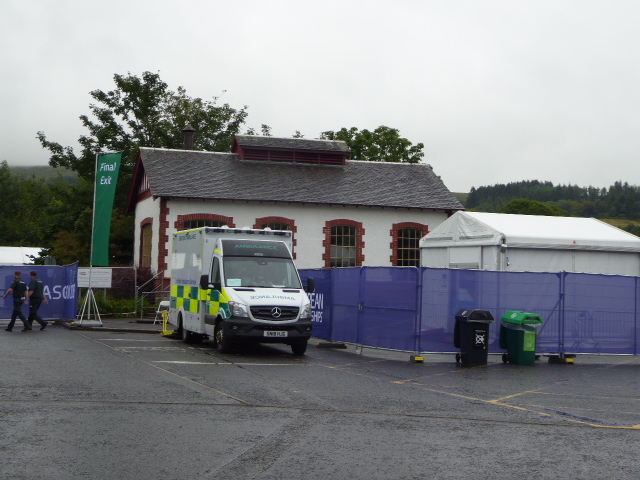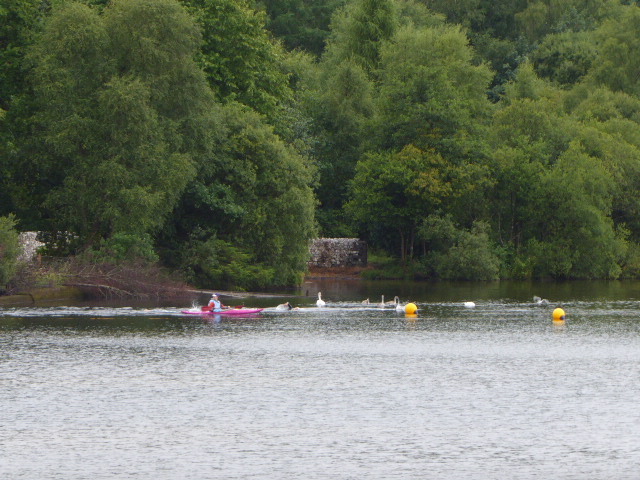
I was out in Balloch yesterday. There was an ambulance and crew parked and waiting just outside the area that has been cordoned off from the public for the European open water swimming championships. The explanation for this appears to have been that competitors for the championships were trying out their courses:

I don’t know whether the kayakers who were accompanying the swimmers – there were lots of both – were there for health and safety reasons, being used by coaches or there to ensure the swimmers took the correct route. The ambulance, however, could only have been there for their health and safety. It was hard not to be struck by the contrast between the precautions taken to protect competitors and the precautions taken to protect the public from the hazards created by the dredging of the course (see here).
The LLTNPA were asked about the dredging of Drumkinnon Bay in an information request which they responded to on 29th June Dredging-of-Loch-Lomond just a few days before Rebin Rehan was drowned. It has been published on their website, a great step forward for transparency, and there was a question about health and safety the response to which makes interesting reading:
Question “I would also like to know when and if a warning sign will be put in place”
Response “There has been signage in place at this location for a number of years advising of the dangers that the uneven surface under the water presents. However additional temporary signage was installed on Friday 25th May 2018, with a further two large signs being installed in recent weeks. Despite the planned remedial works to the bay area to remove the high spots that were created as the dredging contractor removed from site, it is likely that the landowner will keep the new advisory signage in place reminding visitors this area is uneven underfoot and to exercise caution if entering the water.”
So, health and safety concerns were brought to the attention of the LLTNPA by a member of the public – well down them! – and sometime after the dredging finished some additional signs were put in place. This is effectively an admission that for a time there was insufficient signage in place to warn the public of the new hazards that had been created. That, and the description of the dredged ground as “uneven” when actually what appears to have happened is the steep artificial drops have been created, suggests there are a number of issues which need to be addressed by a Fatal Accident Inquiry.
There is a wider issue here, beyond how we protect the public from hazards created under the aegis of our public authorities, and that is the role of our National Parks in reducing drowning accidents in Scotland. In Scotland, on average there are 50 drowning accidents each year, almost double the rate of accidental drowning then in England and Wales. A reflection partly of our wonderful coastline and abundance of lochs. I cannot find any statistics for Loch Lomond but accidents are reported in the media with persistent regularity and it is partly as a result of this that the loch has its own lifeboat, the Loch Lomond Rescue Boat (see here), run by volunteers. It does have a counter on its website giving the time since the last accident took place – an indication of the seriousness of the issue. As well as responding to incidents, they and the wider boating community have a fantastic record in providing safety support to the mass swimming events which have become so popular on Loch Lomond.
Scotland now has a drowning prevention strategy (see here) which aims to reduce the number of people who drown by 50% by 2026. This recommends that drowning prevention strategies should be developed across Scotland’s 32 Local Authorities but makes no mention of National Parks. I would suggest that both our National Parks, as access authorities and leads for Outdoor Recreation, should also be developing drowning prevention strategies but that this is particularly urgent for the LLTNPA given the extent of water in the National Park and the number of accidents that involve the general public (rather than specialised pursuits such as kayaking or jet skiing).
Whatever the role of the LLTNPA in the accident at Drumkinnon Bay, if there had been higher levels of awareness among staff as a whole about water safety – and had they the time to do things properly – one cannot but help thinking that one accident anyway could have been avoided. My suspicion is that the Park’s water based rangers are only too aware of the issues but, while the LLTNPA continues to spend a fortune on No Camping signs (£70,975 in 2017-18, £25,975 over budget) they have no money to warn the general public about water hazards. This is something their forthcoming Outdoor Recreation Plan, due for consultation later this year, should address.

The fact this National park allowed dredging to happen in the first place by a company who everyone knows made a complete mess of! Is a disgrace , I sent them a foi regarding all this and the reply was basic not good enough , Drumkinnon bay has been allowed to dwindle away bit by bit for years! The huge rocks Lomond Shores have put in place are a disgrace an eye sore and just there to stop people sitting on the sand enjoying themselves , all this and the illegal butchering of trees , the camping bylaws and the lack of safety and concern for the people and the area and Loch truly makes me believe they are incompetent and the worst thing that ever happened to Loch Lomond . It’s all a money making scheme that’s all it is, Where are the local people on the board etc ? How many meetings does this park have with the local community etc ? It’s a shambles
Hi Emma, thanks for your comment – had not thought about the bouldering along the shore (you are completely right about this, its terrible for recreation) – and assume from this you were the person who made the FOI I gave a link to; brilliant you did this. We need more people to ask questions of the National Park. Nick
I noticed there is a “No Fishing” notice up at Lomond Shores. We can discuss the legal status of that later. For now I think it is a good idea to have the presence of anglers on the water for health and safety reasons. Anglers drown as well and there have been many losses on the R. Leven over the years. However, I have to weigh that against the number of times myself and others have warned people, adults and children, of the dangers and helped to avoid more tragedies. There’s an old local saying…”Never turn your back on the Leven.” I would never turn my back on The Loch either. It’s freezing.
James, this is really interesting – I had not thought that the attempted clearance of anglers from west side of Loch Lomond and much of east shore by banning camping had health and safety ramifications but it clearly does. Many anglers know the dangers as you say and can warn people; the Park has cleared out that free warning service and put nothing in its place. If the LLTNPA was prepared to work with people who care deeply about the area instead of banning them it could achieve a great deal………………….
T he dredging of drukinnon bay and leaving it with fatal consequences is shocking. Where was the health and safety executive, is it a case that the creation of a warning sign for dangerous and potentially fatal modification can be ignored if eventually a warning sign is put up. All we need are masses of warning signs (disclaimers) so we can implement dangerous
conditions with impunity.